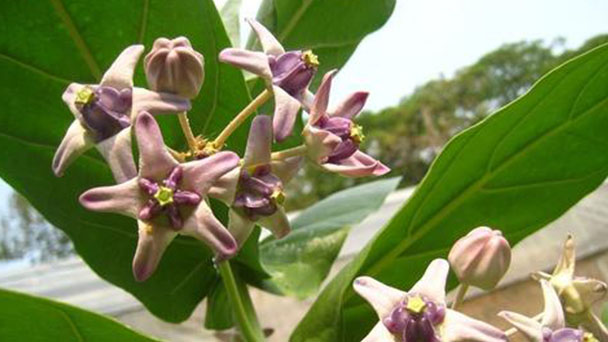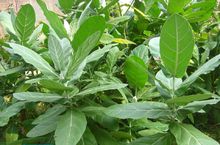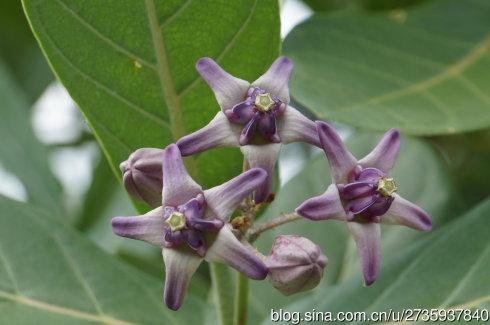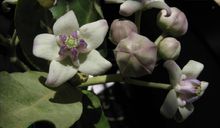Giant milkweed (Calotropis gigantea) profile
Written by Maggie
Mar 19 2021

Giant milkweed (Calotropis gigantea), also called crown flower, is an erect shrub, up to 3 m high, poisonous. Giant milkweed is produced in Yunnan, Sichuan, Guangxi and Guangdong provinces and regions. It has high economic and medicinal value.
Giant milkweed picture

Morphological characteristics of giant milkweed
Cauline leaf
Giant milkweed is an upright shrub, up to 3 m tall, and the whole plant has milk; Stems are yellow and white, thick branches, young branches are part of the gray white villi. Leaves are ovate-oblong or ellipsoid-oblong, 8 -- 20 cm long and 3.5 -- 9.5 cm wide, apical acute, base cordate; Both sides are covered with grayish white tomentose, old gradually shedding; Lateral veins are 4-6 on each side, distanced; Petiole is extreme, sometimes leaf base extrapulse.
Flowers
Cyme shape of Giant milkweed, axillary and terminal; Pedicels and pedicels are gray-white tomentose, pedicels 2 -- 2.5 cm long; Calyx lobes are ovoid; Corolla is purplish blue, radiate, 3 -- 4 cm in diam., lobes ovoid, 1.5 cm long and 1 cm wide, acute; Corolla lobes are shorter than the stamen column, apical inward, base SPAR.
Fruit
Follicles of giant milkweed are solitary, inflated, tip curved, 7 -- 9 cm long, 3 cm in diameter, pubescent; Seeds are broadly ovate, 5 mm long and 3 mm wide, apically with white silky stud hairs; The seed hair is 2.5 cm long.
Giant milkweed grows almost all year round.
Ecological habits of giant milkweed
Giant Milkweed grows on low elevation sunny slopes, open fields and by the sea.
The distribution region of giant milkweed
Giant milkweed grows in Yunnan, Sichuan, Guangxi and Guangdong provinces.
The Giant milkweed is found in India, Sri Lanka, Myanmar, Vietnam and Malaysia.
How to propagate giant milkweed
Giant milkweed mainly propagates as seedlings, blossoms annually, and fruits mature mainly in summer and autumn.
It needs to be before planting the seed soaking in warm water for 12 h, planted in non-woven bag, generally cover depth of about 1 cm, it is helpful for its seed germination, to keep the soil moist after sowing, the survey found seeds can germinate after 1 week, and the germination rate can reach more than 80%, to grow to about 40 d can transplant, transplanting survival rate can reach more than 85%.Giant milkweed can be planted all year round in the Rehe Valley area, but in order to grow fast and strong seedlings, it usually needs to be planted in spring.

How to grow and care for giant milkweed
Giant milkweed plants need to adopt cold frame to its cultivation, plant spacing for 60 cm * 60 cm grow more easily, seedlings after 10 d, every 15 d 1 liquid fertilizer, fertilizer with n, p and k is given priority to, in order to promote flowering late seedling growth and fruit enlargement, phosphate and potash to the main, giant milkweed plant height to 40 cm long can blossom, the flower is heavy, but the final result of inflorescence is less, so the management need to pass through the hydrophobic treatment to reduce nutrient loss, the flowering and fruiting to increase the demand for nutrients of trees. To increase the use of organic fertilizer. Giant milkweed grows at a fast speed and will form a large canopy density. Some branches will slowly lose vitality and die. Therefore, the tree body needs to be pruned in different seasons, such as cutting off the core in spring and cutting off the dead and overdense branches in winter. In addition, a certain degree of pest and disease control is also needed for the Giant milkweed.
Giant milkweed uses
Medicinal value
Giant Milkweed has a wide range of medicinal properties and is considered as a traditional medicinal plant in India. Its roots, stems, leaves and fruits are used for medicinal purposes. Giant milkweed has anti-inflammatory, anti-bacterial, expectorant and detoxifying properties and is used for the treatment of diseases such as leprosy, asthma, cough, ulcers and tumors. The milk of Giant Milkweed can strengthen the heart, protect the liver, relieve pain and reduce inflammation, and its bark can treat epilepsy.In 2009, related experts from the Tropical Crop Variety Resources Institute of Chinese Academy of Tropical Agricultural Sciences made two new anti-cancer patents of Giant milkweed extract in China through compounds with anti-cancer effects extracted from the Giant milkweed.
The milk of the stem and leaves is poisonous and contains a variety of strong heart glucosides. Giant milkweed is used for medicinal purposes and is used to treat skin diseases, dysentery, rheumatism and bronchitis.Bark can cure epilepsy.
The economic value
After the fruit of Giant Milkweed is deseeded, the coronet fiber of its seed is taken, and the coronet fiber is tanned and softened, so that the fiber with certain softness can be obtained. Giant Milkweed fiber is used in textile production as a substitute for cotton fiber. The woven fabric has many advantages, including not only the smooth texture of silk, but also certain air permeability and comfort. It is a new ecological and environmental protection fiber material worthy of promotion. The stem and bark fibers of Giant Milkweed can be used for making rope, papermaking, artificial cotton, woven linen and sacks, etc. The seed wool can be used as filling material and raw material for velvet. Giant Milkweed fiber is similar to kapok fiber in that its cross-section has a large hollow-degree and can be used as a potential water-absorbing and oil-absorbing material, thermal insulation material and buoyancy material, etc.
The stem bark fiber of Giant milkweed can be used for papermaking, making rope and artificial cotton, weaving linen and sacks; The seed wool can be used as raw material and filling material for velvet. Dried milk can be used as gum raw materials, but also to make tanning and yellow dyes. The whole plant can be used as green manure.

Latest Updated
- Benefits of Bugleweed - 7 Science-backed Health Benefits
- Bugleweed Dangers & Side Effects - Is It Poisonous?
- How to Plant Evergreen Trees - What You Should Know
- When to Plant Evergreens - Grow Guide for Evergreen Trees
- 12 Wonderful Evergreen Shrubs for Your Garden
- 12 Popular Evergreen Plants with Pictures for Beginners
- When And How To Prune A Lilac Bush Like a Pro
- How to Grow & Care for Lilac Vine (Hardenbergia Violacea)
- Japanese Lilac Tree (Syringa Reticulata) Care & Propagation Guide
- Shumard Oak Pros and Cons - What to Know
Popular Articles
- Winter maintenance of Antirrhinum Majus
- How to Grow Terminalia Mantaly Tree
- How to Grow and Care for Crossostephium Chinense
- How to grow Antirrhinum Majus in spring
- Peristeria Elata (Dove Orchid) Profile: Info & Care Guide
- Underwatered Snake Plant (Sansevieria Trifasciata) - Signs And How To Fix
- How to Care for Brazilian Jasmine Plant (Mandevilla Sanderi)
- How to Grow & Care for Graptopetalum Purple Delight in Summer
- Rosa Chinensis (China Rose): Plant Growing & Care Tips
- How to Care for Baby Sun Rose (Aptenia Cordifolia)